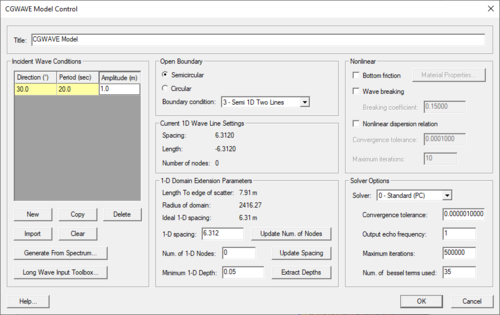SMS:CGWAVE Model Control
From XMS Wiki
Jump to navigationJump to search
The CGWAVE model requires several user-specified parameters to control the analysis. The Model Control command from the CGWAVE menu opens the Model Control dialog. This dialog contains parameters that control the execution of CGWAVE. The parameter description for each field is displayed in SMS using the interactive help messages.
Controls include:
- Title
- Enter the simulation name. This will be used for naming the generated datasets during the model run.
- Incident Wave Conditions
- The Incident Wave Conditions section specifies wave conditions to be simulated in a run. See CGWAVE Incident Wave Conditions for more information.
- Open Boundary
- The Open Boundary section specifies the open boundary type. This should match the type selected when generating the domain in the Map Module. If the mesh has been generated using other methods, the domain shape must match the Open Boundary type.
- Semicircular
- Circular
- Boundary condition:
- 1-D Options
- The 1-D section specifies the number of nodes and the nodal spacing for the one-dimensional data that is used to distribute incident wave data to the open boundary. The file format is described in the CGWAVE user manual[1]. The Compute 1-d Length button calculates the 1-d Spacing variable such that the specified number of nodes will extend to the limits of the bathymetry data. This bathymetry data is defined by a scattered dataset. Therefore, a scatter dataset must exist in order for this button to be active. If no scatter data exists, generate an appropriate file containing the one-dimensional depth values.
- Current 1D Wave Line Settings
- Spacing:
- Length:
- Number of nodes:
- 1D Domain Extension Parameters
- Length to edge of scatter:
- Radius of domain:
- Ideal 1D spacing:
- 1D spacing
- Num. of Nodes
- Minimum 1D Depth
- Update Num. of Nodes
- Update Spacing
- Extract Depths
- Solver Options
- CGWAVE support two separate numerical solvers for robustness. Select which solver to use via the Solver radio group. The Standard solver should be utilized first. If CGWAVE fails to converge, the Modified method can be utilized.
- Solver:
- Convergence tolerance:
- Output echo frequency:
- Maximum iterations:
- Num. of bessel terms used:
- Iteration Control
- CGWAVE allows specifying the maximum number of iteration to be performed by the numerical solver. This number is specified in the Maximum Iterations edit field. The solver will terminate after performing the maximum number of iterations or when the change in the solution is less than the convergence tolerance specified in the Convergence Tolerance edit field. It is recommended that the convergence value be between 1.0e-6 and 1.0e-9. CGWAVE will print a progress report on the tolerance at the user specified report interval entered in the Convergence Interval edit field.
- General Parameters
- CGWAVE includes options to model bottom friction, wave breaking and nonlinear dispersion. These options may be enabled using the appropriate toggle box. See the CGWAVE user manual for more information about these parameters.
- Bottom friction
- Wave breaker
- Breaking coefficient
- Nonlinear dispersion relation
- Convergence tolerance
- Maximum iterations
Related Topics
| [hide] SMS – Surface-water Modeling System | ||
|---|---|---|
| Modules: | 1D Grid • Cartesian Grid • Curvilinear Grid • GIS • Map • Mesh • Particle • Quadtree • Raster • Scatter • UGrid |  |
| General Models: | 3D Structure • FVCOM • Generic • PTM | |
| Coastal Models: | ADCIRC • BOUSS-2D • CGWAVE • CMS-Flow • CMS-Wave • GenCade • STWAVE • WAM | |
| Riverine/Estuarine Models: | AdH • HEC-RAS • HYDRO AS-2D • RMA2 • RMA4 • SRH-2D • TUFLOW • TUFLOW FV | |
| Aquaveo • SMS Tutorials • SMS Workflows | ||
